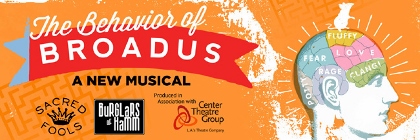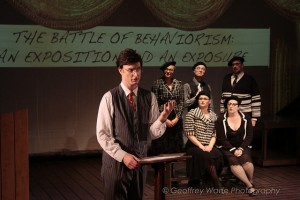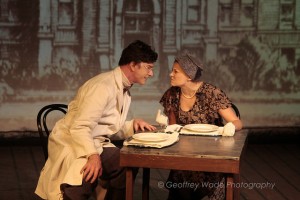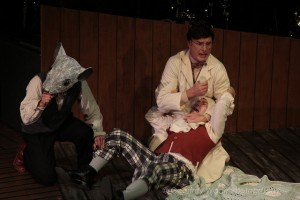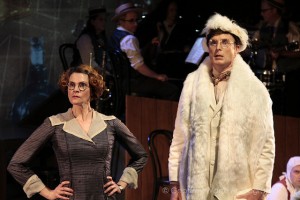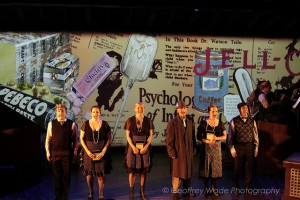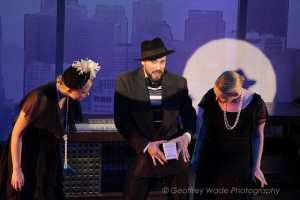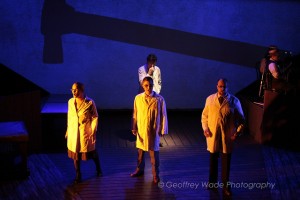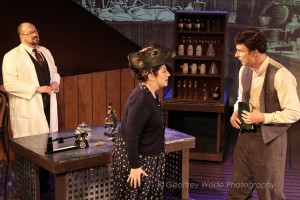STRANGE BUT WATCHABLE BEHAVIOR
Let’s see if I got this right. A tongue-in-cheek bio-musical and pseudo-adventure tale about John Broadus Watson’”wannabe preacher-turned-behavioral scientist-turned-ad man’”includes anthropomorphized barnyard animals, family drama, a love story, a talking lab rat, and a vaudevillian, Weill-esque score (from oompah and jazz to spirituals) ’¦ and this hydra-headed musical doesn’t suck?! Credit that to the imagination overload and stylish, crazy humor of fanciful choreographer and director Ken Roht, Sacred Fools Theater Company, and creators Carolyn Almos, Matt Almos, Jon Beauregard, and Albert Dayan (a performing and writing collective know as Burglars of Hamm).
Using projection design (Jason H. Thompson), mobile sets (Tifanie McQueen), Depression-Prairie costumes (Ann Closs-Farley), and scene-shifting lights (Brandon Baruch), this “sort-of-true story” (per the press release) begins as a Nicholas Nickleby-type adventure as characters from Watson’s childhood come and go until he departs the South for Chicago, where he tries to spread the word of the Lord. Soon, he enters the University of Chicago and goes on the path to earning a PhD and becoming a well-known child psychologist and, later, controversial author.
A precursor to Dr. Spock, Watson is best-known for his 1920 emotional conditioning experiment at Johns Hopkins University. In the study, Watson and graduate student Rosalie Rayner exposed a 9-month-old tot, whom they dubbed “Little Albert,” to a white rat and other furry objects, which the baby enjoyed playing with. Later, as Albert played with the white rat, Watson would make a loud sound behind the baby’s head. After a number of conditioning trials, Watson and Rayner reintroduced the animals and furry items without the scary noise. Through the conditioning, the animals and objects that were once a source of joy and curiosity had become a trigger of fear. It’s conditioning that makes Dr. Phil look like Mother Teresa.
In The Behavior of Broadus, Phil the Rat (Andrew Joseph Perez) and Little Albert (Amir Levi) are Disneyfied into a buddy relationship. Later in Act II, they will become voices of conscience to an older, contemplative Watson (a powerhouse central performance by Hugo Armstrong), who abandoned Little Albert as experimental fodder after the Father of Behaviorism was ejected from Johns Hopkins for his scandalous affair with Rayner (Devin Sidell). The rollicking first act is a credible but sort-of-unlikely narrative filled with anachronistic obscenities and musical comedy characters. It’s a startlingly refreshing blend of the American gumption of Oklahoma! and the satire of Urinetown.
But the love story of now-married Rayner and Watson doesn’t have the weight to carry Act II, which drags with self-importance as Watson moves into advertising and eventually comes to terms with his past beliefs via his two sons. The true love story in this show’”and the reason Act I is far superior’”is between Little Albert and Phil the Rat, two disparate creatures with a true affection for each other who are torn asunder by a torturous scientist with altruistic motives: Watson wants to make the world a better place to compensate for his rearing by an alcoholic father and evangelical mother’”which is also why the Act I choice to have the young Watson conversing with farm animals while converting them to Christ is brilliant (although I wondered why the actors didn’t exhibit zoological qualities).
Ultimately, this is a kick-the-tires production of a promising musical which is on the right track but has yet to separate the chaff from the wheat. Some bits are inspired, some go too far, and some need to go back to the drawing board. The score needs variation and the lyrics could use more humor and sophistication, and many of the songs (by the Burglars, Brendan Milburn, and Matt Almos) end confusingly. The five-piece band handles Milburn’s authentic 1920s-era arrangements beautifully: Ryan O’Connell, keys; John Ballinger and Korey Simeone, strings; Michael Teoli, bass and tuba; and Adrienne Geffen, reeds.
Roht and co-director Matt Almos make excellent use of the space, and the choreography is characteristic Roht: capricious and effectively simple. It may be that Matt Almos is wearing too many hats already to also be co-director: The show desperately needs a shaper who can handle so many creators’”it veers too far from the tone set up at the start. But by god, I love what they’re going for as well as the devout seriousness with which they treat their subject matter. (And here’s hoping they can find a way to add the character of Watson’s real-life granddaughter, actress Mariette Hartley!)
Sacred Fools is one of the few genre-busting troupes in Los Angeles to rival the many companies in Chicago that use theater as a way to tell stories and unleash the imagination. Even when the material falls short (as it does here), the attention to detail is preposterously original, the talent is awesome, and the design team is proof that a limited budget can actually unleash creativity. For both its weaknesses and strengths, this workshop production on gorgeously detailed steroids is a great escape and mandatory viewing for anyone interested in creating musical theater.
photos by Geoffrey Wade Photography
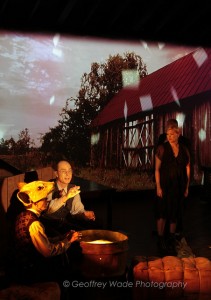 The Behavior of Broadus
The Behavior of Broadus
Sacred Fools Theater Company
and Burglars of Hamm
in association with Center Theatre Group
Sacred Fools Theater
660 N. Heliotrope in Hollywood
Fri and Sat at 8; Sun at 3
scheduled to end on October 18, 2014EXTENDED to October 25, 2014
for tickets, call (310) 281-8337
or visit www.sacredfools.org
